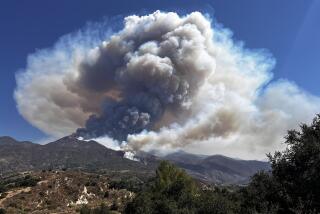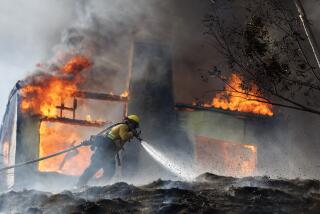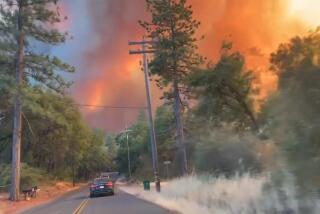Editorial: Rebuild Paradise? California has to reconsider putting homes in the path of more dangerous fires

As the fast-moving Camp fire closed in on the Sierra foothill city of Paradise and the few roads out of town clogged with cars, residents literally had to run for their lives, the soles of their sneakers melting on the asphalt. The escape from Paradise was terrifying, deadly — and predictable.
The entire town is in a high-risk fire zone. Residents have had to evacuate regularly in recent years. During a fire in 2008 that destroyed more than 80 homes on the edge of Paradise, residents were stuck in traffic jams as flames burned on both sides of the road. A grand jury report following that fire said the city and county needed more evacuation routes and should consider halting new home construction in fire-prone areas until thorough emergency plans were in place.
Paradise developed a plan for staggered evacuations of its estimated 27,000 residents. But the plan proved inadequate in the face of the Camp fire, which was so fast and so intense that it leveled the town. At least 81 people died and more than 17,000 homes and commercial buildings were destroyed in the deadliest fire in California history.
To rebuild Paradise as it was would be land-use malpractice.
With thousands of newly homeless Paradise evacuees bivouacking in parks and parking lots, officials are already discussing how to get people home and back to normal quickly. But there’s no more normal. California is facing the new abnormal, with climate change expected to fuel more frequent, more destructive fires.
To rebuild Paradise as it was would be land-use malpractice. The question facing state and local authorities is whether Paradise — and other towns that have burned — can be rebuilt to withstand the next, inevitable wildfire. If not, how does California relocate communities and restrict new construction while respecting property rights and not worsening the state’s affordable housing crisis?
At a minimum, cities should remap fire-prone areas and focus reconstruction in areas with lower risk. They should design fire breaks and buffer zones between open space and developed properties. Rebuilt communities must have sufficient evacuation routes and the most stringent, fire-resistant construction. Structures that didn’t burn should be retrofitted, replacing wood roofs and flammable vegetation. Cities need to enforce requirements that residents empty leaf-clogged rain gutters and clear a 100-foot perimeter of defensible space around their homes to reduce the chance that an ember will set their home on fire.
All of this work comes with significant upfront costs, which is why so few local governments do it. The state should consider providing grants or loans to help local communities cover the costs of fire prevention and resilience. After all, the cost of inaction is far greater.
But are there some areas of the state that are just too dangerous to build or rebuild in? In 1993, after fires raged through Malibu, Joseph T. Edmiston, the head of the Santa Monica Mountains Conservancy, called for a “three-strikes” rule to limit the number of times recovery funds could be spent to help rebuild a home destroyed by wildfire.
Lawmakers can’t necessarily stop people from rebuilding, given the 5th Amendment’s protections for property owners. But Edmiston suggested that California could offer to buy out property owners to prevent them from rebuilding in high-risk areas and use the land for park space. The federal government already has a program that buys out homes that have repeatedly flooded. Participation is voluntary, and it’s a humane way to compensate property owners and deter them from rebuilding again in harm’s way. Policymakers should develop a similar effort for wildfire ravaged communities in California.
Enter the Fray: First takes on the news of the minute from L.A. Times Opinion »
Other experts have suggested the creation of a state commission, much like the California Coastal Commission, that would have authority over new development in hazardous fire zones. Local control over land-use has been sacrosanct in California, but it’s clear that a patchwork, parochial approach to approving development in high-risk fire areas has failed protect the public.
Indeed, California cities and counties — motivated in part by the state’s housing crisis — continue to approve new housing developments deeper into high-risk fire areas, as the suburbs march into rural foothills and high property values force people farther and farther away from urban centers. The Los Angeles County Planning Commission recently OK’d the 19,000-home Centennial project on Tejon Ranch. Developing in the wildland urban interface, where homes and offices abut foothills, forests or other open land, increases both the risk of starting fires and the number of people and structures in harm’s way when there is a fire. The vast majority of wildfires are caused by humans or their tools of modern living, including sparks from vehicles and power lines. Utility companies certainly have to do more to prevent fires from their equipment, but stringing new power lines to serve customers in far-flung wildland areas only increases the potential for disaster.
There are good reasons why so many people flock to urban fringe and foothill communities. It’s beautiful living on the edge of nature, and housing is often much cheaper there than in California’s coastal regions. Yet the death and destruction of the last year should be a wake-up call that California can’t continue to sprawl into increasingly dangerous wildfire terrain.
Follow the Opinion section on Twitter @latimesopinion and Facebook
More to Read
A cure for the common opinion
Get thought-provoking perspectives with our weekly newsletter.
You may occasionally receive promotional content from the Los Angeles Times.










